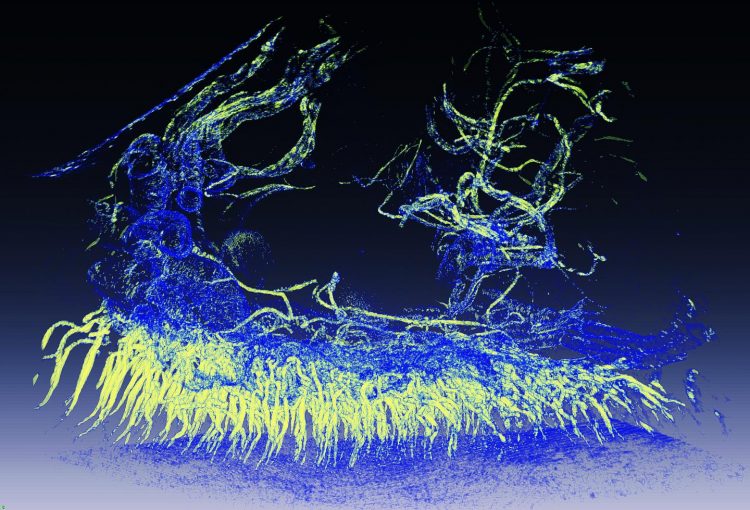Unraveling the light of fireflies

This detailed microimage shows larger channels branching into smaller ones, supplying oxygen for the firefly's light emission. The smallest channels are ten thousand times smaller than a millimeter and therefore invisible to other experimental probes: this has prevented scientists so far to unlock the mystery of firefly light flashes. Credit: Giorgio Margaritondo/EPFL
We know that this reaction needs oxygen, but what we don't know is how fireflies actually supply oxygen to their light-emitting cells. Using state-of-the-art imaging techniques, scientists from Switzerland and Taiwan have determined how fireflies control oxygen distribution to light up their cells. The work is published in Physical Review Letters.
The firefly's light-producing organ is called the “lantern”, and it is located in the insect's abdomen. It looks like a series of tubes progressing into smaller ones and so one, like a tree's branches growing into twigs. The function of these tubes, called, is to supply oxygen to the cells of the lantern, which contain luciferase and can produce light. However, the complexity of the firefly's lantern has made it difficult to study this mechanism in depth, and reproduce it for technological applications.
Giorgio Margaritondo at EPFL, Yeukuang Hwu at the Academia Sinica and their colleagues at the National Tsing Hua University in Taiwan have successfully used two sophisticated imaging techniques to overcome the complexity of the firefly lantern and map out how oxygen is supplied to light-emitting cells. The techniques are called synchrotron phase contrast microtomography and transmission x-ray microscopy. They can scan down to the level of a single cell, even allowing researchers to look inside it.
By applying these techniques on live fireflies, the scientists were able to see the entire structure of the lantern for the first time, and to also make quantitative evaluations of oxygen distribution.
The imaging showed that the firefly diverts oxygen from other cellular functions and puts it into the reaction that breaks up luciferin. Specifically, the researchers found that oxygen consumption in the cell decreased, slowing down energy production. At the same time, oxygen supply switched to light-emission.
The study is the first to ever show the firefly's lantern in such detail, while also providing clear evidence that it is optimized for light emission thanks to the state-of-the-art techniques used by the scientists. But Margaritondo points out another innovation: “The techniques we used have an advantage over, say, conventional x-ray techniques, which cannot easily distinguish between soft tissues. By using an approach based on changes in light intensity (phase-contrast) as opposed to light absorption (x-rays), we were able to achieve high-resolution imaging of the delicate firefly lantern.”
This work represents a collaboration of EPFL with the following institutes in Taiwan: Academia Sinica, the National Tsing Hua University, the Endemic Species Research Institute, the National Taiwan University, and the National Cheng Kung University.
Reference
Tsai Y-L, Li C-W, Hong T-M, Ho J-Z, Yang E-C, Wu W-Y, Margaritondo G, Hsu S-T, Ong EBL, Hwu Y. Firefly Light Flashing: Oxygen Supply Mechanism. Physical Review Letters 17 December 2014.
Media Contact
More Information:
http://www.epfl.chAll latest news from the category: Life Sciences and Chemistry
Articles and reports from the Life Sciences and chemistry area deal with applied and basic research into modern biology, chemistry and human medicine.
Valuable information can be found on a range of life sciences fields including bacteriology, biochemistry, bionics, bioinformatics, biophysics, biotechnology, genetics, geobotany, human biology, marine biology, microbiology, molecular biology, cellular biology, zoology, bioinorganic chemistry, microchemistry and environmental chemistry.
Newest articles

NASA: Mystery of life’s handedness deepens
The mystery of why life uses molecules with specific orientations has deepened with a NASA-funded discovery that RNA — a key molecule thought to have potentially held the instructions for…

What are the effects of historic lithium mining on water quality?
Study reveals low levels of common contaminants but high levels of other elements in waters associated with an abandoned lithium mine. Lithium ore and mining waste from a historic lithium…

Quantum-inspired design boosts efficiency of heat-to-electricity conversion
Rice engineers take unconventional route to improving thermophotovoltaic systems. Researchers at Rice University have found a new way to improve a key element of thermophotovoltaic (TPV) systems, which convert heat…



